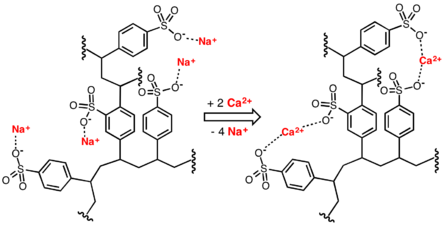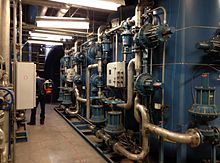Ion exchange


Ion exchangeis a reversible interchange of one species of ion present in an insoluble solid with another of like charge present in a solution surrounding the solid. Ion exchange is used in softening or demineralizing of water, purification of chemicals, and separation of substances.
Ion exchange usually describes a process of purification of aqueous solutions using solidpolymericion-exchange resin.More precisely, the term encompasses a large variety of processes where ions are exchanged between twoelectrolytes.[1]Aside from its use to purify drinking water, the technique is widely applied for purification and separation of a variety of industrially and medicinally important chemicals. Although the term usually refers to applications of synthetic (human-made) resins, it can include many other materials such as soil.
Typical ion exchangers areion-exchange resins(functionalized porous orgelpolymer),zeolites,montmorillonite,clay,andsoilhumus.Ion exchangers are eithercation exchangers,which exchange positivelychargedions (cations), oranion exchangers,which exchange negatively charged ions (anions). There are alsoamphotericexchangersthat are able to exchange both cations and anions simultaneously. However, the simultaneous exchange of cations and anions is often performed inmixed beds,which contain a mixture of anion- and cation-exchange resins, or passing the solution through several different ion-exchange materials.

Ion exchangers can have binding preferences for certain ions or classes of ions, depending on the physical properties andchemical structureof both the ion exchanger and ion. This can be dependent on the size, charge, or structure of the ions. Common examples of ions that can bind to ion exchangers are:
- H+(proton) and OH−(hydroxide).
- Singly charged monatomic (i.e., monovalent) ions likeNa+,K+,andCl−.
- Doubly charged monatomic (i.e., divalent) ions likeCa2+andMg2+.
- Polyatomicinorganicions likeSO2−
4andPO3−
4. - Organic bases,usuallymoleculescontaining theaminefunctional group−NR2H+.
- Organic acids,oftenmoleculescontaining −COO−(carboxylic acid) functional groups.
- Biomoleculesthat can be ionized:amino acids,peptides,proteins,etc.
Along withabsorptionandadsorption,ion exchange is a form ofsorption.
Ion exchange is areversible process,and the ion exchanger can beregeneratedorloadedwith desirable ions by washing with an excess of these ions.

Types[edit]
Cation exchange[edit]
- CM (Carboxymethyl group, weak cation exchange)
- SP (sulphopropyl group, strong cation exchange)
Anion exchange[edit]
Ion exchange resins[edit]
Ion exchange resins are the physical medium that facilitates ion exchange reactions. The resin is composed of cross-linked organic polymers, typically polystyrene matrix and functional groups where the ion exchange process takes place.
Cation exchange resins[edit]
- Strong acid cation (SAC) resins:Composed of a polystyrene matrix with a sulphonate (SO3-) functional group. Used in softening or demineralization processes.
- Weak acid cation (WAC) resins:Composed of an acrylic polymer and carboxylic acid functional groups. Used to selectively remove cations associated with alkalinity.
Anion exchange resins[edit]
- Strong base anion (SBA) resins:
- Type 1 SBA resins:Greatest affinity for the weak acids and commonly present during a water demineralization process.
- Type 3 SBA resins:Lower chemical stability than Type 1 but better regeneration efficiency.
- Weak base anion (WBA) resins:Act as acid absorbers; capable of sorbing strong acids with a high capacity and are readily regenerated with caustic.
Chelating resins[edit]
Used to exchange heavy metals from alkaline earth and alkali metal solutions.
Adsorbents[edit]
Used for organic compound removal.
Applications[edit]
Ion exchange is widely used in the food and beverage industry, hydrometallurgy, metals finishing, chemical, petrochemical, pharmaceutical technology, sugar and sweetener production, ground- and potable-water treatment, nuclear, softening, industrial water treatment, semiconductor, power, and many other industries.[citation needed]
A typical example of application is preparation of high-purity water forpower engineering,electronic and nuclear industries; i.e.polymericorinorganicinsolubleion exchangers are widely used forwater softening,water purification,[2][3]waterdecontamination,etc.
Ion exchange is a method widely used in household filters to producesoft water for the benefit oflaundry detergents, soaps,and water heaters. This is accomplished by exchanging divalent cations (such ascalciumCa2+andmagnesiumMg2+) with highly soluble monovalent cations (e.g., Na+or H+) (seewater softening). Another application for ion exchange in domestic water treatment is the removal ofnitrateandnatural organic matter.In domestic filtration systems ion exchange is one of the alternatives for water softening in households along with reverse osmosis (RO) membranes. Compared to RO membranes, ion exchange requires repetitive regeneration when inlet water is hard (has high mineral content).[citation needed]
Industrial and analyticalion-exchange chromatographyis another area to be mentioned. Ion-exchange chromatography is achromatographicalmethod that is widely used for chemical analysis and separation of ions. For example, inbiochemistryit is widely used to separate charged molecules such asproteins.An important area of the application is extraction and purification of biologically produced substances such as proteins (amino acids) andDNA/RNA.
Ion-exchange processes are used to separate and purifymetals,including separatinguraniumfromplutoniumand the otheractinides,includingthorium,neptunium,andamericium.This process is also used to separate thelanthanides,such aslanthanum,cerium,neodymium,praseodymium,europium,andytterbium,from each other. The separation of neodymium and praseodymium was a particularly difficult one, and those were formerly thought to be just one elementdidymium– but that is an alloy of the two.[citation needed]
There are two series ofrare-earth metals,the lanthanides and the actinides, both of whose families all have very similar chemical and physical properties. Using methods developed byFrank Speddingin the 1940s, ion-exchange processes were formerly the only practical way to separate them in large quantities, until the development of the "solvent extraction" techniques that can be scaled up enormously.
A very important case of ion-exchange is the plutonium-uranium extraction process (PUREX), which is used to separate the plutonium (mainly239
Pu) and theuranium(in that case known asreprocessed uranium) contained inspent fuelfromamericium,curium,neptunium(theminor actinides), and thefission productsthat come fromnuclear reactors.Thus the waste products can be separated out for disposal. Next, the plutonium and uranium are available for making nuclear-energy materials, such as new reactor fuel (MOX-fuel) and (plutonium-based)nuclear weapons.Historically some fission products such asStrontium-90orCaesium-137were likewise separated for use asradionuclidesemployed in industry or medicine.
The ion-exchange process is also used to separate other sets of very similar chemical elements, such aszirconiumandhafnium,which is also very important for the nuclear industry. Physically, zirconium is practically transparent to free neutrons, used in building nuclear reactors, but hafnium is a very strong absorber of neutrons, used in reactorcontrol rods. Thus, ion-exchange is used innuclear reprocessingand the treatment ofradioactive waste.
Ion-exchange resins in the form of thinmembranesare also used inchloralkali process,fuel cells,andvanadium redox batteries.


Ion exchange can also be used to remove hardness from water by exchanging calcium and magnesium ions for sodium ions in an ion-exchange column. Liquid-phase (aqueous) ion-exchangedesalinationhas been demonstrated.[5]In this technique anions and cations in salt water are exchanged for carbonate anions and calcium cations respectively usingelectrophoresis.Calcium and carbonate ions then react to formcalcium carbonate,which then precipitates, leaving behind fresh water. The desalination occurs at ambient temperature and pressure and requires no membranes or solid ion exchangers. The theoretical energy efficiency of this method is on par withelectrodialysisandreverse osmosis.
Other applications[edit]
- Insoil science,cation-exchange capacityis the ion-exchange capacity ofsoilfor positively charged ions. Soils can be considered as natural weak cation exchangers.
- In pollution remediation andgeotechnical engineering,ion-exchange capacity determines the swelling capacity of swelling orexpansive claysuch asmontmorillonite,which can be used to "capture" pollutants and charged ions.
- In planarwaveguidemanufacturing, ion exchange is used to create the guiding layer of higherindex of refraction.
- Dealkalization,removal of alkali ions from aglasssurface.
- Chemically strengthened glass,produced by exchanging K+for Na+insoda glasssurfaces using KNO3melts.
Advantages and limitations[edit]
Advantages[edit]
- Selective removal:Ion exchange resins can be designed to selectively remove specific ions from water.
- High efficiency:Ion exchange processes can achieve high removal efficiencies for targeted ions.
- Regenerability:Ion exchange resins can be regenerated multiple times by flushing them with a regenerating solution, extending their lifespan and reducing operational costs.
- Versatility:Ion exchange can be applied to various water treatment applications.
- Consistent performance:Ion exchange systems offer consistent and predictable performance, providing reliable water treatment over time.
- Scalability:Ion exchange systems can be easily scaled up or down to meet different treatment capacities and requirements.
Limitations[edit]
- Removal limitations:If target ions are present in complex mictures or at low concentrations, additional pre-treatment or post-treatment may be required.
- Regeneration requirements:Regeneration of ion exchange resins requires the use of chemicals and generates wastewater containing concentrated contaminants, which may require appropriate handling and disposal measures.
- Limited capacity:Ion exchange resins have finite capacities for adsorbing ions, and once saturated, they must be regenerated or replaced, which can limit their effectiveness in treating high-concentration or high-volume streams.
- Complexity:Ion exchange systems can be complex to design, operate, and maintain, requiring specialized knowledge and expertise.
Waste water produced by resin regeneration[edit]
Most ion-exchange systems use columns of ion-exchangeresinthat are operated on a cyclic basis.
During the filtration process, water flows through the resin column until the resin is considered exhausted. That happens only when water leaving the column contains more than the maximal desired concentration of the ions being removed. Resin is then regenerated by sequentially backwashing the resin bed to remove accumulated suspended solids, flushing removed ions from the resin with a concentrated solution of replacement ions, and rinsing the flushing solution from the resin. Production of backwash, flushing, and rinsingwastewaterduring regeneration of ion-exchange media limits the usefulness of ion exchange forwastewater treatment.[6]
Water softeners are usually regenerated withbrinecontaining 10%sodium chloride.[7]Aside from the soluble chloride salts of divalent cations removed from the softened water, softener regeneration wastewater contains the unused 50–70% of the sodium chloride regeneration flushing brine required to reverse ion-exchange resin equilibria. Deionizing resin regeneration withsulfuric acidandsodium hydroxideis approximately 20–40% efficient. Neutralized deionizer regeneration wastewater contains all of the removed ions plus 2.5–5 times theirequivalent concentrationassodium sulfate.[8]
See also[edit]
- Alkali anion-exchange membrane
- Ion
- Ion chromatography
- Ion-exchange membranes
- Ion-exchange resin
- Desalination
- Reverse osmosis
References[edit]
- ^Dardel, François; Arden, Thomas V. (2008). "Ion Exchangers".Ullmann's Encyclopedia of Industrial Chemistry.Weinheim: Wiley-VCH.doi:10.1002/14356007.a14_393.pub2.ISBN978-3527306732.
- ^Ibrahim, Yazan; Naddeo, Vincenzo; Banat, Fawzi; Hasan, Shadi W. (1 November 2020). "Preparation of novel polyvinylidene fluoride (PVDF)-Tin(IV) oxide (SnO2) ion exchange mixed matrix membranes for the removal of heavy metals from aqueous solutions ".Separation and Purification Technology.250:117250.doi:10.1016/j.seppur.2020.117250.S2CID224880249.
- ^Ibrahim, Yazan; Abdulkarem, Elham; Naddeo, Vincenzo; Banat, Fawzi; Hasan, Shadi W. (November 2019). "Synthesis of super hydrophilic cellulose- Alpha zirconium phosphate ion exchange membrane via surface coating for the removal of heavy metals from wastewater".Science of the Total Environment.690:167–180.Bibcode:2019ScTEn.690..167I.doi:10.1016/j.scitotenv.2019.07.009.PMID31288108.S2CID195870880.
- ^Mischissin, Stephen G. (7 February 2012)."University of Rochester – Investigation of Steam Turbine Extraction Line Failures"(PDF).Arlington, VA. pp. 25–26. Archived fromthe original(PDF)on 23 September 2015.Retrieved23 February2015.
- ^Shkolnikov, Viktor; Bahga, Supreet S.; Santiago, Juan G. (August 28, 2012)."Desalination and hydrogen, chlorine, and sodium hydroxide production via electrophoretic ion exchange and precipitation"(PDF).Physical Chemistry Chemical Physics.14(32). Phys. Chem. Chem Phys: 11534–45.Bibcode:2012PCCP...1411534S.doi:10.1039/c2cp42121f.PMID22806549.Archived fromthe original(PDF)on December 8, 2021.RetrievedJuly 9,2013.
- ^Kemmer, pp. 12–17, 12–25.
- ^Betz Laboratories Inc. (1980).Betz Handbook of Industrial Water Conditioning – 8th Edition.Betz. p.52.Archived fromthe originalon 2012-06-20.
- ^Kemmer, pp. 12–18.
Further information[edit]
- Betz Laboratories (1976).Handbook of Industrial Water Conditioning(7th ed.). Betz Laboratories.
- Ion Exchangers (K. Dorfner, ed.), Walter de Gruyter, Berlin, 1991.
- C. E. Harland, Ion exchange: Theory and Practice, The Royal Society of Chemistry, Cambridge, 1994.
- Friedrich G. Helfferich (1962).Ion Exchange.Courier Dover Publications.ISBN978-0-486-68784-1.
- Kemmer, Frank N. (1979).The NALCO Water Handbook.McGraw-Hill.
- Ion exchange (D. Muraviev, V. Gorshkov, A. Warshawsky), M. Dekker, New York, 2000.
- A. A. Zagorodni,Ion Exchange Materials: Properties and Applications,Elsevier, Amsterdam, 2006.
- SenGupta, Arup K. (2017).Ion exchange in environmental processes: fundamentals, applications and sustainable technology.Hoboken, NJ.ISBN978-1-119-42125-2.OCLC1001290476.
{{cite book}}:CS1 maint: location missing publisher (link) - Dr., I., & Luqman, M. (2012).Ion Exchange Technology I : Theory and Materials.Springer Netherlands.
- Harland, C. E. (1994).Ion exchange : theory and practice (2nd ed.).The Royal Society of Chemistry.
